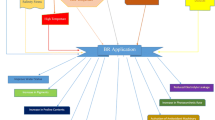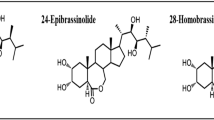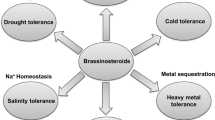Abstract
Brassinosteroids (BRs) are plant steroid hormones which can regulate several physiological effects in plants, including promotion of cell growth and induction of heat stress tolerance. BR-biosynthesis and signaling mutants show a striking dwarf phenotype and these mutants may therefore lead to intrinsic cellular stress. However, how stress mechanisms could function during BR action is poorly understood. This review will focus on stress gene/protein and metabolites that have showed to be altered during BR-induced heat tolerance and as a result of changed BR content and perception. Recent studies on proteomics and microarray of BR-treated tissues or BR-related mutants have revealed up/down regulation of specific enzymes/genes related to reactive oxygen scavenging, redox control, protein folding, and others. We will specifically discuss potential roles for Heat Shock Proteins, Antioxidant metabolites and enzymes in BRinduced thermal tolerance. In addition, as stress mechanisms are not exclusive of plants under stressful situations, the review will also discuss on how these protective factors may be implicated in classical BR effects during normal growth stimulation. Putative models to explain the role of Antioxidants, Oxidants and Heat Shock Proteins in BR action will be presented.
Access this chapter
Tax calculation will be finalised at checkout
Purchases are for personal use only
Preview
Unable to display preview. Download preview PDF.
Similar content being viewed by others
References
Anderson, J. A. 2002. Catalase activity, hydrogen peroxide content and thermotolerance of pepper leaves. Sci. Hort., 95(4): 277–284.
Apel, K., and Hirt, H. 2004. Reactive oxygen species: metabolism, oxidative stress, and signal transduction. Ann. Review Plant Biol., 55: 373–399.
Bajguz, A. 2009. Brassinosteroid enhanced the level of abscisic acid in Chlorella vulgaris subjected to short-term heat stress. J. Plant Physiol.,166(8): 882–886.
Bajguz, A., and Hayat, S. 2009. Effects of brassinosteroids on the plant responses to environmental stresses. Plant Physiol. Biochem. 47(1):1–8.
Cao, S., Xu, Q., Cao, Y., Qian, K., An, K., Zhu, Y., Binzen, H., Zhao, and Kuai, B. 2005. Loss-of-function mutations in DET2 gene lead to an enhanced resistance to oxidative stress in Arabidopsis. Physiol. Plant., 123: 57–64.
Clouse, S.D., and Sasse, J.M. 1998. Brassinosteroids: Essential Regulators of Plant Growth and Development. Ann. Rev. Plant. Physiol. Plant Mol. Biol., 49: 427–451.
Confraria, A., Desikan, R., Santos, I., Neill, S. 2007. Brassinosteroids protect plants against heat stress. Comparative Biochem. Physiol., 146(4): S279
Dane, F., Hunter, A.G., and Chambliss, O.L. 1991. Fruit set, pollen fertility, and combining ability of selected tomato genotypes under high temperature field conditions. J. Amer. Hort. Sci., 116: 906–910.
Deng, Z., Zhang, X., Tang, W., Oses-Prieto, J. A., Suzuki, N., Gendron, J. M., Chen, H., Guan, S., Chalkley, R. J., Peterman, T. K., Burlingame, A. L., and Wang, Z. Y. 2007. A Proteomic Study of Brassinosteroid Response in Arabidopsis. Mol. Cell. Proteomics., 11: 451–467.
Dhaubhadel, S., Browning, K.S., Gallie, D.R., Krishna P., 2002. Brassinosteroid functions to protect the translational machinery and heat-shock protein synthesis following thermal stress. Plant J., 29(6): 681–691.
Dhaubhadel, S., Chaudhary, S., Dobinson, K., and Krishna, P. 1999. Treatment with 24-epibrassinolide, a brassinosteroid increases the basic thermotolerance of Brassica napus and tomato seedlings. Plant Mol. Biol., 40: 333–342.
Foyer, C.H., and Noctor, G. 2005. Redox Homeostasis and antioxidant signaling: A metabolic interface between stress perception and physiological responses. Plant Cell., 17:1866–1875.
Friedrich, K.L., Giese, K.C., Buan, N.R., and Vierling, E. 2004. Interactions between small heat shock protein subunits and substrate in small heat shock protein–substrate complexes. J. Biol. Chem., 279: 1080–1089.
Goda, H., Sawa, S., Asami, T., Fujioka, S., Shimada, Y., and Yoshida, S. 2004. Comprehensive comparison of auxin-regulated and brassinosteroid-regulated genes in Arabidopsis. Plant Physiol., 134:1555–1573.
Goda, H., Shimada, Y., Asami, T., Fujioka, S., and Yoshida, S. 2002. Microarray analysis of brassinosteroid-regulated genes in Arabidopsis. Plant Physiol., 130:1319–1334.
Hong, S.W., Lee, U., Vierling, E., 2003. Arabidopsis hot Mutants Define Multiple Functions Required for Acclimation to High Temperatures. Plant Physiol., 132:757–767.
Huang, B., Chu, C-H., Chen, S-L., Juan, H-F., and Chen, Y-M. 2006. A proteomics study of the mung bean epicotyl regulated by brassinosteroids under conditions of chilling stress. Cell. Mol. Biol. Letters, 11: 264–278.
Kagale, S., Divi, U.K., Krochko, J.E., Séller, W.A., and Krishna, P. 2007. Brassinosteroid confers tolerance in Arabidopsis thaliana and Brassica napus to a range of abiotic stresses. Planta., 225: 353–364.
Khripach, V., Zhabinskii, V., and De Groot, A. 1999. Brassinosteroids. A new Class of Plant Hormones. Academic Press. New York. 456p.
Koh, S., Lee, S. Ch., Kim, M. K., Koh, J. H., Lee, S., An, G., Choe, S., and Kim, S. R. 2007. T-DNA tagged knockout mutation of rice OsGSK1, an orthologue of Arabidopsis BIN2, with enhanced tolerance to various abiotic stress. Plant Mol. Biol., 65: 453–466.
Konishi, H., and Komatsu, S. 2003. A proteomics approach to investigating promotive effects of brassinolide on lamina inclination and root growth in rice seedlings. Biol. Pharm. Bull., 26:401–408.
Kotak, S., Larkindale, J., Lee, U., Koskull-Doring, P.V., Vierling, E., and Scharf, K.D. 2007. Complexity of the heat stress response in plants. Curr. Opin. Plant Biol., 10: 310–316.
Krishna, P. 2003. Brassinosteroid-Mediated Stress Responses. J. Plant Growth Regul., 22(4): 289–297.
Kulaeva, O.N., Burkhanova, E.A., Fedina, A.B., Kaokhlova, V.A., and Bokebayeva, G.A. 1991. Effect of brassinosteroids on protein synthesis and plant-cell-ultrastructure under stress conditions. In H.G., Cutler., T, Yokota., G, Adam, (Eds.), Brassinosteroids: Chemistry, Bioactivity and Applications: American Chemical Society: pp. 141-155.
Kurepin, L.V., Qaderi, M.M., Back, T.G., Reid, D.M., and Pharis, R.P. 2008. A rapid effect of applied brassinolide on abscisic acid concentrations in Brassica napus leaf tissue subjected to short-therm heat stress. Plant Growth Regul., 55: 165–167.
Larkindale, J., Mishkind, M., and Vierling, E. 2005a. Plant responses to high temperature. In M.A., Jenks, P.M., Hasegawa, (Eds.), Plant Abiotic Stress. Blackwell Publishing: pp. 100-144.
Larkindale, J., Hall, J.D., Knight, M.R., and Vierling, E. 2005b. Heat stress phenotypes of Arabidopsis mutants implicate multiple signaling pathways in the acquisition of thermotolerance. Plant Physiol., 138:882–897.
Larkindale, J., and Huang, B. 2004. Thermotolerance and antioxidant systems in Agrostis stolonifera: involvement of salicylic acid, abscisic acid, calcium, hydrogen peroxide, and ethylene. J. Plant Physiol., 161:405–413.
Larkindale, J., and Knight, M.R., 2002. Protection against heat stress-induced oxidative damage in Arabidopsis involves calcium, abscisic acid, ethylene, and salicylic acid. Plant Physiol., 128: 682–695.
Larkindale, J., and Vierling, E. 2008. Core Genome Responses involved in acclimation to High Temperature. Plant Physiol., 146: 748–761.
Lee, U., Wie, C., Escobar, M., Williams, B., Hong, S.W., and Vierling, E. 2005. Genetic analysis reveals domain interactions of Arabidopsis Hsp100/ClpB and cooperation with the small heat shock protein chaperone system. Plant Cell., 17: 559–571.
Liberet, K., Lewndowska, A., and Zietkiewicz, S. 2008. Chaperones in control of protein disaggregation. EMBO J., 27: 328–335.
Liu, H.T., Liu, Y. Y., Pan, Q.H., Yang, H. R., Zhan, J.C., and Huang, W.D. 2006. Novel interrelationship between salicylic acid, abscisic acid, and PIP2-specific phospholipase C in heat acclimation-induced thermotolerance in pea leaves. J. Exp. Bot., 57: 3337–3347.
Liu, Y., Zhao, Z., Si, P., Di, C., Han, J., and An, L. 2009. Brassinosteroids alleviate chilling-induced oxidative damage by enhancing antioxidant defense system in suspension cultured cells of Chorispora bungeana. Plant Growth Regul., 59: 207–214.
Mazorra, L. M., 2009. Los brasinoesteroides y su relación con la tolerancia de plántulas de tomate al calor. Doctoral Thesis. Faculty of Biology. University of Havana. Cuba. 100p.
Mazorra, LM., and Núñez, M. 2006. Inducción de termo-tolerancia por la 24-epibrasinólida y dos análogos espirostánicos de brasinoesteroides en plantas de tomate. Cult. Trop., 27(3): 89–93.
Mazorra, L. M., Núñez, M., Hechavarría, M., Coll, F., and Sánchez-Blanco, M.J. 2002. Influence of brassinosteroids on antioxidant enzymes activity in tomato under different temperatures. Biologia Plantarum., 45(4): 593–596.
Mittler, R. 2002. Oxidative stress, antioxidants and stress tolerance. Trends Plant Sci., 7: 405–410.
Mussig, C., Fischer, S., and Altmann, T. 2002. Brassinosteroid-regulated gene expression. Plant Physiol., 129:1241–1251.
Nemhauser, J.L., Mockler, T.C. and Chory, J. 2004. Interdependency of brassinosteroid and auxin signaling in Arabidopsis. PLoS Biol., 2: E258.
Neta-Sharir, I., Isaacson, T., Lurie, S., and Weiss, D. 2005. Dual role for tomato heat shock protein 21: protecting photosystem II from oxidative stress and promoting color changes during fruit maturation. Plant Cell. 17:1829–1838.
Núñez, M., Robaina, C., and Coll, F. 2003. Synthesis and practical applications of brassinosteroid analogs. In S., Hayat., A., Ahmad., Brassinosteroids. Bioactivity and Crop Productivity. Kluwer Academic Publishers. The Netherlands: p. 87–117.
Ogweno, J.O., Son, X.S., Shi, K., Hu, W. H., Mao, W.H., Zhou, Y. H., Yu, J.Q., and Nogués, S. 2008. Brassinosteroid alleviate heat-induced inhibition of photosynthesis by increasing carboxylation efficiency and enhancing antioxidant systems in Lycopersicon esculentum. J. Plant Growth Regul., 27:49–57.
Rivero, R.M., Ruiz, J.M., and Romero, L. 2004. Oxidative metabolism in tomato plants subjected to heat stress. J. Hort. Sci. Biotechnol., 79:560–564.
Sanmiya, K., Suzuki, K., Egawa, Y., and Shono, M. 2004. Mitochondrial small heat-shock protein enhances thermotolerance in tobacco plants. FEBS Lett., 557:265–268.
Singh, I., and Shono, M. 2003. Effect of 24-epibrassinolide on pollen viability during heat-stress in tomato. Indian J. Exp. Biol., 41: 174–176.
Singh, I., and Shono, M. 2005. Physiological and molecular effects of 24-epibrassinolide, a brassinosteroid, on thermotolerance of tomato. Plant Growth Regul., 47: 111–119.
Szekeres, M., Nemeth, K., Konez-Kalman, Z., Mathur, J., Kauschann, A., Altmann, T., Redei, G.P., Nagy, F., Schell, J., and Koncz, C. 1996. Brassinosteroids rescue the deficiency of CYP90, a cytochrome P450 controlling cell elongation and de-etiolation in Arabidopsis. Cell., 85: 171–182.
Vacca, R.A., de Pinto M.C., Valenti, D., Passarella, S., Marra, E., and De Gara, L., 2004. Production of reactive oxygen species, alteration of cytosolic ascorbate peroxidase, and impairment of mitochondrial metabolism are early events in heat shock induced programmed cell death in tobacco bright-yellow 2 cells. Plant Physiol., 134: 1100–1112.
Vierling, E. 1991. The roles of heat proteins in plants. Ann. Rev. Plant Mol. Biol., 42:579–620.
Volkov, R.A., Panchuk, I.I., Mullineaux, P.M., and Schoffl, F., 2006. Heat stress-induced H2O2 is required for effective expression of heat shock genes in Arabidopsis. Plant Mol. Biol., 61: 733–746.
Wang, H., Feng, T., Peng, G.X., Yan, M., Zhou, P., and Tang, X. 2009. Ameliorative effects of brassinosteroid on excess manganese-induced oxidative stress in Zea mays L. leaves. Agric. Sci. China., 8: 1063–1074.
Weaver, M. L., Timm, H., 1989. Screening tomato for high temperature tolerance through pollen viability tests. Hort. Sci., 24: 493–495.
Wilen, R.W., Sacco, M., Gusta, L.V., Krishna, P., 1995. Effects of 24-epibrassinolide on freezing and thermotolerance of bromegrass (Bromus inermis) cell cultures. Physiol. Plant., 95:195–202.
Willenkens, H., Chamnongpol, S., Davey, M., Schraudner, M., Langebartels, C., Van Montagu, M., Inze, D., and Van Camp, W. 1997. Catalase is a sink for H2O2 and is indispensable for stress defence in C3 plants. EMBO J., 16: 4806–4816.
Young, J.C., Moarefi, I., and Hartl, F.U. 2001. Hsp90: a specialized but essential protein-folding tool. J. Cell Biol., 154: 267–273.
Zhou, Y.H., Yu, J.Q., Huang, L.F., and Nogués, S. 2004. The relationship between CO2 assimilation, photosynthetic electron transport and water-water cycle in chill-exposed cucumber leaves under low light and subsequent recovery. Plant Cell Environ., 27: 1503–1514.
Zhou, Y.H., Yu, J.Q., Mao, W.H., Huang, L.F., Song, S., and Nogués, S. 2006. Genotypic variation on Rubisco expression, photosynthetic electron flow and antioxidant metabolism in the chloroplasts of chill-exposed cucumber plants. Plant Cell Physiol., 47: 192–199.
Zhu, C., Zeng, G.W., and Liu, F., 1996. Effect of epi-brassinolide on the heat shock tolerance and antioxidant metabolism in cucumber seedling. J. Zhejiang Agric. Univ., 22(3): 284–288.
Author information
Authors and Affiliations
Editor information
Editors and Affiliations
Rights and permissions
Copyright information
© 2011 Springer Science+Business Media B.V.
About this chapter
Cite this chapter
Mazorra, L.M. (2011). Brassinosteroid action and its relation with heat stress mechanisms in plants. In: Hayat, S., Ahmad, A. (eds) Brassinosteroids: A Class of Plant Hormone. Springer, Dordrecht. https://doi.org/10.1007/978-94-007-0189-2_10
Download citation
DOI: https://doi.org/10.1007/978-94-007-0189-2_10
Published:
Publisher Name: Springer, Dordrecht
Print ISBN: 978-94-007-0188-5
Online ISBN: 978-94-007-0189-2
eBook Packages: Biomedical and Life SciencesBiomedical and Life Sciences (R0)




